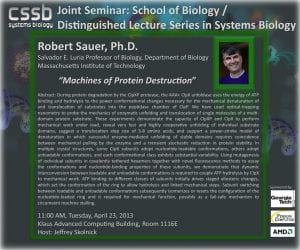 Distinguished Lecture Series Guest Speaker: Robert SauerSalvador E. Luria Professor of Biology
Distinguished Lecture Series Guest Speaker: Robert SauerSalvador E. Luria Professor of Biology
Department of Biology
Massachusetts Institute of Technology
Date & Time: Tuesday,April 23, 2013, 11:00AM
Location: Klaus 1116E
Host: Jeffrey Skolnick
Abstract: During protein degradation by the ClpXP protease, the AAA+ ClpX unfoldase uses the energy of ATP binding and hydrolysis to the power conformational changes necessary for the mechanical denaturation of and translocation of substrates into the peptidase chamber of ClpP. We have used optical-trapping nanometry to probe the mechanics of enzymatic unfolding and translocation of single molecules of a multi-domain protein substrate. These experiments demonstrate the capacity of ClpXP and ClpX to perform mechanical work under load, reveal very fast and highly cooperative unfolding of individual substrate domains, suggest a translocation step size of 5-8 amino acids, and support a power-stroke model of denaturation in which successful enzyme-mediated unfolding of stable domains requires coincidence between mechanical pulling by the enzyme and a transient stochastic reduction in protein stability. In multiple crystal structures, some ClpX subunits adopt nucleotide-loadable conformations, others adopt unloadable conformations, and each conformational class exhibits substantial variability. Using mutagenesis of individual subunits in covalently tethered hexamers together with novel fluorescence methods to assay the conformations and nucleotide-binding properties of these subunits, we demonstrate that dynamic interconversion between loadable and unloadable conformations is required to couple ATP hydrolysis by ClpX to mechanical work. ATP binding to different classes of subunits initially drives staged allosteric changes, which set the conformation of the ring to allow hydrolysis and linked mechanical steps. Subunit switching between loadable and unloadable conformations subsequently isomerizes or resets the configuration of the nucleotide-loaded ring and is required for mechanical function, possibly as a fail-safe mechanism to circumvent machine stalling.
Additional Information: The Sauer Lab uses biophysical, genetic, structural, and design strategies to study the relationship between the sequence, stability, and three-dimensional structures of proteins. They are also interested in the mechanisms that intracellular proteases use to select the correct targets and how ATP-dependent proteases catalyze protein denaturation.
